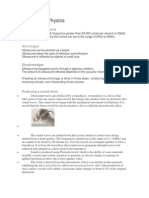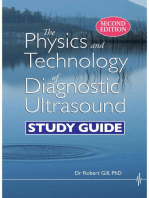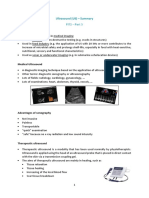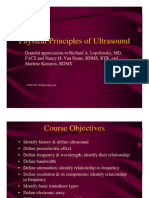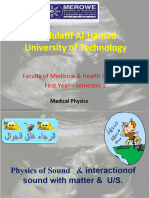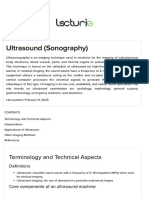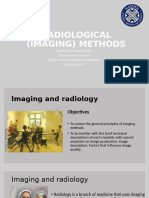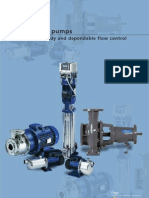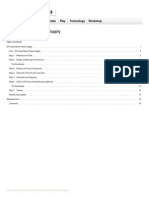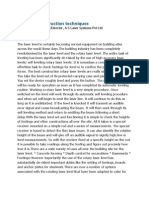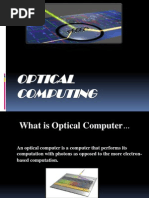0 ratings0% found this document useful (0 votes)
26 viewsBreast Ultrasound: Basic Physics and Instrumentation
Breast Ultrasound: Basic Physics and Instrumentation
Uploaded by
Lorena ZaroniuThis document discusses the basic physics and instrumentation of breast ultrasound. It covers topics such as ultrasound wave properties including frequency, wavelength and propagation in tissues. It also discusses ultrasound transducers, display modes, artifacts, and new techniques such as harmonic imaging, compound imaging, 3D imaging and elastography. The goal of the document is to provide knowledge about optimizing and interpreting breast ultrasound images.
Copyright:
© All Rights Reserved
Available Formats
Download as PPT, PDF, TXT or read online from Scribd
Breast Ultrasound: Basic Physics and Instrumentation
Breast Ultrasound: Basic Physics and Instrumentation
Uploaded by
Lorena Zaroniu0 ratings0% found this document useful (0 votes)
26 views23 pagesThis document discusses the basic physics and instrumentation of breast ultrasound. It covers topics such as ultrasound wave properties including frequency, wavelength and propagation in tissues. It also discusses ultrasound transducers, display modes, artifacts, and new techniques such as harmonic imaging, compound imaging, 3D imaging and elastography. The goal of the document is to provide knowledge about optimizing and interpreting breast ultrasound images.
Original Title
Basic US Equipment
Copyright
© © All Rights Reserved
Available Formats
PPT, PDF, TXT or read online from Scribd
Share this document
Did you find this document useful?
Is this content inappropriate?
This document discusses the basic physics and instrumentation of breast ultrasound. It covers topics such as ultrasound wave properties including frequency, wavelength and propagation in tissues. It also discusses ultrasound transducers, display modes, artifacts, and new techniques such as harmonic imaging, compound imaging, 3D imaging and elastography. The goal of the document is to provide knowledge about optimizing and interpreting breast ultrasound images.
Copyright:
© All Rights Reserved
Available Formats
Download as PPT, PDF, TXT or read online from Scribd
Download as ppt, pdf, or txt
0 ratings0% found this document useful (0 votes)
26 views23 pagesBreast Ultrasound: Basic Physics and Instrumentation
Breast Ultrasound: Basic Physics and Instrumentation
Uploaded by
Lorena ZaroniuThis document discusses the basic physics and instrumentation of breast ultrasound. It covers topics such as ultrasound wave properties including frequency, wavelength and propagation in tissues. It also discusses ultrasound transducers, display modes, artifacts, and new techniques such as harmonic imaging, compound imaging, 3D imaging and elastography. The goal of the document is to provide knowledge about optimizing and interpreting breast ultrasound images.
Copyright:
© All Rights Reserved
Available Formats
Download as PPT, PDF, TXT or read online from Scribd
Download as ppt, pdf, or txt
You are on page 1of 23
Breast ultrasound
basic physics and instrumentation
Dr. Dominique Amy
Centrul de Diagnostic in Imagistica Medicala – Aix en Provence,
Franta
Dr. Viorela Enachescu
Clinica Medicala III, UMF Craiova
EcoMamoDuct – Workshop – Breast ultrasound
Craiova – 30 nov.- 01 dec. 2007
Introduction
• Because of its accessibility and low cost ultrasound
is considered to be an easy and simple technique.
• However, optimization and interpretation of an
sonographic image demands large knowledge,
adequate training and experience.
• A lot depends on the quality of the machine.
A(t ) A0 sin(t )
Frequency and wavelength
• The ideas of frequency, phase and wavelength can be
applied to any kind of waves, independently of their
physical properties.
• The ultrasound wave may be modeled as:
• A(t) = Aosin (t - )
• where:
• A0 – amplitude of the wave
• t - time
- frequency
- phase
Ultrasonic wave
• Wavelength is the length of space over which one complete
cycle occurs (in a simple harmonic wave it may be e.g. the
distance between two subsequent maxima or minima of the
wave).
• With constant frequency the wavelength becomes longer
when the velocity is higher.
• With constant velocity it becomes shorter with growing
frequency.
• Wavelengths of the ultrasound in tissues with usually
applied frequencies are in the range of fractions of
millimeters.
Propagation of
ultrasound in tissues
• Propagation speed - about 1540 m/s. The US speed in
bones and metals is much higher, whereas the propagation
speed in the air is lower than in the soft tissues.
• Acoustic impedance (Z) - D x V
• Reflection of an US wave on a surface between two media
(or tissues ) depends on the velocity and their density.
• The acoustic impedance of all soft tissues is similar
(highest in muscles, lowest in fat).
• The air - very low acoustic impedance (low V and low D),
• The breast - no interfaces (air/bones) exist is well-suited
to ultrasound inspection.
Propagation of
ultrasound in tissues
• Echogenicity - the relative intensity of echoes in the region
of interest - compared to the tissue of reference - breast -
normal fatty tissue.
• If the echoes in the breast lesion are stronger - hyperechoic,
if the echoes are weaker - hypoechoic, and if the intensity
is similar - isoechoic. If no echoes - anechoic – ex. cysts
• Acoustic shadowing behind a structure - result of
absorption and/or reflection.
• Acoustic "enhancement" seen behind low-attenuation
structures, as fluid filled areas (e.g. cysts). In fact this is not
a real enhancement, but rather less attenuation than behind
the adjacent higher attenuation tissues.
Ultrasound attenuation
• Breast cyst.
Anechoic structure,
the ultrasound beam
crossing the cyst is
less attenuated than
the beam crossing
adjacent solid tissue –
acoustic
"enhancement".
Ultrasound attenuation
• Breast carcinoma.
Low reflection –
hypoechoic lesion
• High attenuation –
acoustic shadow
• “Paradoxal effect”
Ultrasound attenuation
• Calcification. High
reflection. Acoustic
shadowing.
Ultrasound transducers
• Basic scanhead designs include convex
(curvilinear) and linear array probes.
• In sonographic examination of the breast - a
superficial organ - linear (linear array)
transducers are used. In the linear (linear array)
transducers the piezoelectric crystals are mounted
on a flat rectangular surface, the field of view is
rectangular (in newer transducers it may be
trapezoid, too).
Transducer and image
parameters
• Spatial resolution - the ability of separation of distinct
objects on the display. In ultrasound the spatial resolution
is different along the direction of the sound beam, and
perpendicular to the beam direction:
• axial resolution ,
• transverse resolution,
• elevational resolution.
• Axial resolution depends mainly on the transducer
frequency (the higher the frequency the better the
resolution), however, the lateral and elevational
frequency depend on the focusing of the ultrasound
beam.
Transducer and image
parameters
• Choosing the transducer frequency
• The highest possible frequency which enabling
visualization of the area of interest should be used.
The range of the ultrasound wave is shorter with
higher frequencies, therefore it is of utmost
importance that the transducer should be placed
as close to the examined organ as possible.
• In breast US minimal frequency used should be
not less than 7.5 MHz, preferably higher.
Transducer and image
•
parameters
Focusing
• The lateral resolution depends on the width of the
ultrasound beam. An ultrasound beam emitted by
a crystal is wide, and beam focusing like in a
camera is necessary.
• The focus should always be located at the level
of the examined structure. Only in this way the
optimal quality and resolution may be obtained.
Modern machines usually allow for focusing of
the beam at several levels.
Display modes
• The echoes in the ultrasound are collected line after
line. The information received in form of echoes
reflected from interfaces met along the ultrasound
beam may be presented in different formats.
• There are 3 basic presentation modes used in the
clinical ultrasound: amplitude (A), brightness (B),
and motion (M) mode. In breast ultrasound the B-
mode is used.
• B (brightness) mode
• In the B-mode the amplitudes of reflections are
coded in the gray-scale. The two-dimensional B-
mode is the fundamental presentation used in the
clinical ultrasound.
Volume measurements
• There are several formulas for calculation of
volume based on measurements of three
orthogonal dimensions of the displayed organ
or lesion. One of the most popular is the
following ellipsoid formula.
• D1, D2, D3 - diameters of examined structure
measured in three orthogonal (perpendicular to
each other) planes.
• This method of calculation of volume may
give inaccurate results, the error can be large
in structures differing from an ellipsoid.
Artifacts
• Reverberations
• Reverberations are artifacts
originating from multiple
reflections of the
ultrasound wave on
parallel reflective layers of
a tissue.
• The reverberation artifact
is common in larger
breast cysts.
Artifacts
• Lateral shadows (edge
shadows)
• Shadows may occur behind
the edges of objects, which
are not strong attenuators.
This may be due to
defocusing action of a
refracting surface, or
destructive interference of
portions of the ultrasound
pulse. Edge shadowing can
be seen in breast cysts.
New ultrasound
techniques
• Harmonic imaging (tissue harmonic imaging, THI)
• If ultrasound wave propagating in a tissue has energy high
enough, it causes vibration not only of frequency
emitted by the transducer but also higher frequencies,
especially waves with frequency twice as high as the
emitted frequency. Because those vibrations originate in
the tissues the intensity of reverberations is diminished,
there are virtually no side-lobe artifacts, however, the
acoustic shadows are stronger.
• Harmonic imaging improves the quality of the image,
enhances the contrast between tissue, and is especially
useful in differential diagnosis of breast cysts.
New ultrasound
•
techniques
Compound imaging (Sono-CT)
• This technique makes possible averaging of several images
obtained with different angles of incidence of emitted
ultrasound beam.
• The images are then combined by the computer into one
image. In the resulting image the patterns of real
structures are reinforced while artifacts such as speckle
and noise are averaged out.
• Suppresses a large portion of acoustic shadows which in
breast ultrasound are an important sign of malignancy. In
routine examinations of the breast compound imaging
should be used with caution as it may decrease the
sensitivity of the examination.
New ultrasound
techniques
• Panoramic imaging (extended field of view)
• Panoramic imaging is a technique in which
subsequent images obtained during a longitudinal
uniform sweeping are pasted together.
• Cross sections of the entire breast on a single
image may be obtained using this technique.
• Sie-scape techmique
New ultrasound
techniques
• 3D-imaging - two stages:
• 1. the acquisition of data, in which a set of contiguous slices of the
examined region are obtained.
• 2. obtained data is computed using one of the typical algorithms:
• multiplanar reformation (MPR),
• maximum intensity projection (MIP),
• minimal intensity projection (mIP),
• shaded surface display (SSD),
• volume rendering (VR).
• Allow obtaining of images in the plane parallel to the surface of the
transducer (the C-plane, or "bird's eye view")may supply additional
information useful in differential diagnosis of breast masses.
• Allow precise and repetitive calculation of volumes and precise planning
of biopsies.
New ultrasound
techniques
• Elastography\
• Elastography compares ultrasonic images of an object
before and after application of a slight compression
differentiating soft and firm portions of imaged area.
• Alternatively a low-frequency vibration may be applied
differentiating moving and immobile
• Breast is well suited for elastographic imaging, since the
normal breast tissue is relatively soft, and breast cancers
are usually stone-hard.
• Value of elastography in breast imaging is under clinical
evaluation.
References
• Goldberg BB (red.) Textbook of abdominal
ultrasound. Williams and Wilkins, Baltimore 1993
• Kremkau FW. Diagnostic ultrasound. Principles and
instruments. WB Saunders Company, Philadelphia,
2002
• Barr RG. Breast ultrasound: a bright future. Medica
Mundi 2001; 45(2): 8-13
• Hiltawsky KM, Krüger M, Starke C, Heuser L, Ermert
H, Jensen A. Freehand ultrasound elastography of
breast lesions: clinical results. Ultrasound Med Biol
2001; 27(11): 1461-1469
You might also like
- BscanDocument92 pagesBscantutsimundi80% (5)
- Ultrasound PhysicsDocument9 pagesUltrasound PhysicsawansurfNo ratings yet
- Ultrasound ImagingDocument103 pagesUltrasound Imagingsolomong100% (1)
- Introduction To Basic UltrasoundDocument25 pagesIntroduction To Basic UltrasoundAriadna Mariniuc100% (4)
- The Physics and Technology of Diagnostic Ultrasound: Study Guide (Second Edition)From EverandThe Physics and Technology of Diagnostic Ultrasound: Study Guide (Second Edition)No ratings yet
- Ficha Tecnica Nikon Npl-820Document4 pagesFicha Tecnica Nikon Npl-820Leonardo Reyes Naranjo67% (3)
- Ultrasound - SummaryDocument19 pagesUltrasound - SummaryHeidar Zaarour0% (1)
- Ultrasonography in Animals-1Document38 pagesUltrasonography in Animals-1achakzaikaka35No ratings yet
- GCEA-September 14Document59 pagesGCEA-September 14RODRIGUE KOUADIONo ratings yet
- 1st ClassDocument65 pages1st Classmequanintmeseret29No ratings yet
- 5.diagnostic ImagingDocument48 pages5.diagnostic Imagingridwanciise147No ratings yet
- Us Mri Ct-ExamDocument68 pagesUs Mri Ct-ExamgetachewNo ratings yet
- Report ContentsDocument32 pagesReport ContentsBrightworld ProjectsNo ratings yet
- Ultrasound Artifact-1Document42 pagesUltrasound Artifact-1Ogbuefi PascalNo ratings yet
- UltrasoundDocument104 pagesUltrasoundlrp sNo ratings yet
- Ultrasonography in AnimalsDocument50 pagesUltrasonography in AnimalsAyushi YadavNo ratings yet
- US SRTLEDocument41 pagesUS SRTLEمحمد عمارNo ratings yet
- Imaging Modalities in Anatomy Lecture NoteDocument46 pagesImaging Modalities in Anatomy Lecture Noteakpakwuisaac3No ratings yet
- D 50 483 491 PDFDocument9 pagesD 50 483 491 PDFlambanaveenNo ratings yet
- Medical Physics Syllabus Notes - Daniel WilsonDocument14 pagesMedical Physics Syllabus Notes - Daniel WilsonPosclutoNo ratings yet
- The Radiographic ImageDocument18 pagesThe Radiographic ImageMohamed AufNo ratings yet
- Basics of Ultrasound OKDocument38 pagesBasics of Ultrasound OKGloria TaneoNo ratings yet
- Physical Principles of UtzDocument44 pagesPhysical Principles of UtzRalph RichardNo ratings yet
- Medical ImagingDocument33 pagesMedical ImagingsamiyaNo ratings yet
- Simple UltrasoundDocument32 pagesSimple UltrasoundyahyaNo ratings yet
- فيزياء 6 Sound USDocument43 pagesفيزياء 6 Sound USabjdhoz111No ratings yet
- Medical Physics Notes - Physics HSCDocument29 pagesMedical Physics Notes - Physics HSCBelinda ZhangNo ratings yet
- EchohandbookhscDocument126 pagesEchohandbookhscMr-deligent Abdalmohsen100% (1)
- Other Imaging Modalities Ultrasound NoteDocument15 pagesOther Imaging Modalities Ultrasound Notelexa42187No ratings yet
- USS Imaging Techniques WA2018Document38 pagesUSS Imaging Techniques WA2018Jake MillerNo ratings yet
- Ultrasound WRDDocument13 pagesUltrasound WRDNaty SeyoumNo ratings yet
- Basics of UsgDocument124 pagesBasics of Usgsabin7000No ratings yet
- UltrasonographyDocument4 pagesUltrasonographyjelianne canilloNo ratings yet
- UZVDocument56 pagesUZVGoran MaliNo ratings yet
- Sem 1, Basic UltrasoundDocument95 pagesSem 1, Basic UltrasoundaghniajolandaNo ratings yet
- 1 Intro To USDocument78 pages1 Intro To USBekalu ZelalemNo ratings yet
- Ultrasound ImagingDocument11 pagesUltrasound ImagingFikret Baz100% (1)
- Animal Care X Ray Training FluoroDocument51 pagesAnimal Care X Ray Training FluoroNagendra BIO-TECHNOLOGYNo ratings yet
- CM Principles of Ultrasound PPDocument16 pagesCM Principles of Ultrasound PPVũ Hoàng AnNo ratings yet
- Ultrasound (Sonography)Document14 pagesUltrasound (Sonography)dr.anuthomas14No ratings yet
- Basic Principles of Diagnostic UltrasonographyDocument5 pagesBasic Principles of Diagnostic UltrasonographyAgung KusastiNo ratings yet
- Basic Principles of Interpretation of USG, CT, MRI - SRDocument38 pagesBasic Principles of Interpretation of USG, CT, MRI - SRChammika DeshanNo ratings yet
- PHY370 Chapter 3 PDFDocument50 pagesPHY370 Chapter 3 PDFaisyahNo ratings yet
- Principles and Application of Investigative and Imaging Techniques-1Document43 pagesPrinciples and Application of Investigative and Imaging Techniques-1Lal NandaniNo ratings yet
- Mam OgraphyDocument13 pagesMam Ographymalihajabbar519No ratings yet
- Point-Of-Care Ultrasonography For ObstetricsDocument22 pagesPoint-Of-Care Ultrasonography For Obstetricssalah subbahNo ratings yet
- Doppler BasicsDocument79 pagesDoppler Basicsdrabdulsamad100% (1)
- Ultra Sound ImagingDocument42 pagesUltra Sound Imagingmanali gawariNo ratings yet
- Lecture 10 Ultrsonic TherapyDocument66 pagesLecture 10 Ultrsonic TherapyA. ShahNo ratings yet
- MI - Ultrasound - Lec 2Document40 pagesMI - Ultrasound - Lec 2Kidus YohannesNo ratings yet
- 1 Radiological MethodsDocument47 pages1 Radiological Methodsnihankilic2No ratings yet
- Basicsofultrasound 170807183128Document145 pagesBasicsofultrasound 170807183128Bunga FaridaNo ratings yet
- FRCR US Lecture 1Document76 pagesFRCR US Lecture 1TunnelssNo ratings yet
- Basic Principles of Ultrasound.: Dr/Abd Allah Nazeer. MDDocument50 pagesBasic Principles of Ultrasound.: Dr/Abd Allah Nazeer. MDAmeer MattaNo ratings yet
- Ultrasound BasicsDocument12 pagesUltrasound BasicsJ100% (1)
- Emergency Radiology: The BasicsDocument68 pagesEmergency Radiology: The BasicsArya Vandy Eka PradanaNo ratings yet
- Grade 2 MSK lec 1,22-23-2 2Document37 pagesGrade 2 MSK lec 1,22-23-2 2frankorangejuiceeNo ratings yet
- WITCO - UT PresentationDocument51 pagesWITCO - UT PresentationJohn OLiver100% (1)
- 1.1 Research Background 1.1.1 Traditional Ultrasound ImagingDocument12 pages1.1 Research Background 1.1.1 Traditional Ultrasound ImagingGhislain AHOUANSENo ratings yet
- Ucm Public HealthDocument66 pagesUcm Public HealthYahye Hassan DaacadNo ratings yet
- Canon LBP 2900 3000 Service ManualDocument136 pagesCanon LBP 2900 3000 Service ManualamitNo ratings yet
- Edic Lecture 1 03082005Document71 pagesEdic Lecture 1 03082005SAAVY SINGHNo ratings yet
- Vision Measuring SystemsDocument19 pagesVision Measuring SystemsAliNo ratings yet
- Calibration of Measuring InstrumentsDocument9 pagesCalibration of Measuring InstrumentsIta SethNo ratings yet
- The Shadowgraph Image - 02Document7 pagesThe Shadowgraph Image - 02Abdullah SalemNo ratings yet
- Discussion GmawDocument2 pagesDiscussion GmawMuhamad HafizNo ratings yet
- Centrifugal Pumps: A World of Steady and Dependable Flow ControlDocument14 pagesCentrifugal Pumps: A World of Steady and Dependable Flow ControlYimmy Alexander Parra MarulandaNo ratings yet
- LLT100 Laser Level Transmitter: Measurement Made EasyDocument26 pagesLLT100 Laser Level Transmitter: Measurement Made EasyGabriela CastroNo ratings yet
- T7111-DAS-1053-A-IFA-Baghouse Datasheet - 20170930 PDFDocument4 pagesT7111-DAS-1053-A-IFA-Baghouse Datasheet - 20170930 PDFtiantaufikNo ratings yet
- Ac130 CFFDocument3 pagesAc130 CFFChristopher LovernNo ratings yet
- PHILIPS DVD Servo 703Document66 pagesPHILIPS DVD Servo 703Sye Sis YElecNo ratings yet
- "Principle of Operation" Page 1-2Document2 pages"Principle of Operation" Page 1-2Nur RahMiNo ratings yet
- Item List: PT Tridinamika Jaya InstrumentDocument5 pagesItem List: PT Tridinamika Jaya InstrumentAndi MulyanaNo ratings yet
- Handbook of Emerging Communications Technologies (Zamir, CRC Press 2000) (423s)Document210 pagesHandbook of Emerging Communications Technologies (Zamir, CRC Press 2000) (423s)hajianamirNo ratings yet
- SHARP-mxm350n M350u m450n M450uDocument12 pagesSHARP-mxm350n M350u m450n M450uIoas IodfNo ratings yet
- Block Diagram and TableDocument2 pagesBlock Diagram and Tablegaurang2020No ratings yet
- LEP 2.2.01 Interference of Light: Related Topics Set-Up and ProcedureDocument3 pagesLEP 2.2.01 Interference of Light: Related Topics Set-Up and ProcedureMuhammad AhmadNo ratings yet
- Module 4ultrasonics and Microwaves (1) (New)Document15 pagesModule 4ultrasonics and Microwaves (1) (New)Agnivesh SharmaNo ratings yet
- DIY Small Bench Power SupplyDocument21 pagesDIY Small Bench Power SupplyMarius DanilaNo ratings yet
- Visual Inspections of Commercial Jet EnginesDocument7 pagesVisual Inspections of Commercial Jet EnginesArabyAbdel Hamed SadekNo ratings yet
- Photodiode Technical Information PDFDocument18 pagesPhotodiode Technical Information PDFAnonymous t7iY7U2No ratings yet
- LIGHT AND ARCHITECTURAL LIGHTING SYSTEMS Part 2Document5 pagesLIGHT AND ARCHITECTURAL LIGHTING SYSTEMS Part 2Shaft SandaeNo ratings yet
- Light SensorsDocument32 pagesLight Sensors0307aliNo ratings yet
- Modern Construction TechniquesDocument19 pagesModern Construction TechniquesLizle Len BanciloNo ratings yet
- Datasheet - V3DX3-010BR21A - 1126983 - Es ENGLIShDocument9 pagesDatasheet - V3DX3-010BR21A - 1126983 - Es ENGLIShAlexander GarCia'No ratings yet
- I SENSYS - MF6680dn p8424 c3947 en - GB 1255426241Document2 pagesI SENSYS - MF6680dn p8424 c3947 en - GB 1255426241polyfaxNo ratings yet
- Lectores de Código en BarrasDocument2 pagesLectores de Código en BarrasIsmael EspinozaNo ratings yet
- 102 Laser Engraving MachineDocument15 pages102 Laser Engraving MachineChaitanya ghewareNo ratings yet
- Final PPT Optical ComputersDocument24 pagesFinal PPT Optical ComputersSaptarshi BhattacharjeeNo ratings yet

